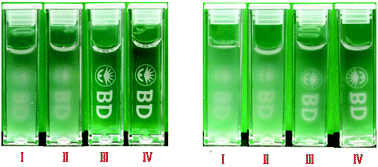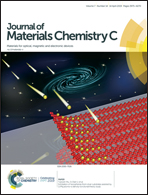Sensing carbon dioxide through a solution transparency change in gas-responsive polymers†
Abstract
The use of thermosensitive polymers exhibiting an upper critical solution temperature (UCST) for sensing and detecting the presence of CO2 in aqueous solution was demonstrated. By synthesizing random copolymers of acrylamide (AAm), acrylonitrile (AN) and N,N-diethylaminoethyl methacrylate (DEAEMA), which have different relative contents of AAm and AN but a similar and small amount of CO2-responsive DEAEMA (below 3%), two means for monitoring the concentration of CO2 through the transparency change of a polymer sensor solution were investigated. On the one hand, using a single P(AAm-co-AN-co-DEAEMA) copolymer whose phase transition-induced transmittance change upon cooling is completed within a narrow temperature range and whose cloud point (CP) is sensitively decreased upon increasing the amount of CO2, the polymer solution at a given temperature (25 °C) allows a threshold concentration of CO2 to be detected by showing an abrupt change in transmittance. On the other hand, by mixing two copolymers with largely different CPs (over 30 K), the sharp UCST-type phase transition is suppressed; instead the change in the solution transmittance upon cooling proceeds slowly and gradually over a wide temperature region (>35 K). The mixed polymer solution can be used to monitor the increase in the amount of CO2 through gradual and mostly linear changes in transmittance. Both abrupt and gradual transparency changes can be observed by the naked eye.

- This article is part of the themed collection: 2019 Journal of Materials Chemistry C HOT Papers


 Please wait while we load your content...
Please wait while we load your content...